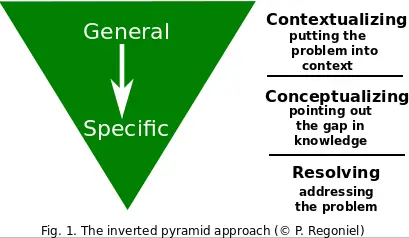How do you about writing a thesis introduction? Is there a way to do it to ensure that you put across the message more effectively? This article discusses one of the ways to make the introduction a logical explanation of the contents of a thesis. Writing the introduction follows a deductive approach. Read on how the general to specific method works.
My previous tip on how to write the introduction explained the importance of a hook. The article is titled “how to write a good hook.” A good hook prompts the readers to go on and read the thesis. This time, I will detail another feature of a good thesis introduction that works well with the hook, that is, writing from general to specific.
Writing a Thesis Introduction: General to Specific
Many seasoned writers or researchers adopt writing from general to specific as the way to go. Although this may seem common sense to those who write a lot and who have a way with words, professors or mentors need to guide their students or mentees. Mentoring provides at least the necessary skills required for better composition.
If you are a student, just finding your way in the scientific world for the first time by engaging yourself in thesis writing, writing a thesis introduction is quite a challenge. If you believe this is so, then you must go on and read my attempt to clarify this approach more fully.
The Inverted Pyramid Approach to Writing a Thesis Introduction
Let me illustrate the deductive writing method using an illustration to guide your thinking. I call this the inverted pyramid of writing a thesis introduction. It follows the general to the specific approach.
I figured out the situation in class while evaluating students’ interpretation of the inverted pyramid writing method. Incisively looking into draft compositions submitted to me, I thought that the concept at best gives just a gist or the tip of the iceberg. Many students find themselves at a loss on how to do it. Concept wise, it’s easy to understand, but applying it is another thing. There is a need to explain the idea further to make it more systematic.
So here it is. I will make the inverted pyramid or general to specific writing approach more detailed and doable. I present below my inverted pyramid concept.

As you will see in Figure 1 above, there are three stages to be considered as you write from general to the specific concerns of the phenomenon.
Three Stages of the Inverted Pyramid Approach
1. Contextualization
First, there should be a contextualization of the situation or phenomenon. Contextualization provides details about the investigated event. A simple way to do this is by applying the 5Ws and 1H technical writing approach. You will not miss essential information using that method as you address the What, When, Where, Who, Why, and How questions. Make it as brief as you can.
2. Conceptualization
Conceptualize based on the issue or concern at hand that you have introduced in the contextualization stage. Conceptualization is a product of reflective and analytical thinking. And thinking is best done when you have gained a lot of experience with the phenomenon you are trying to understand. The primary purpose at this stage is to point out the gap in knowledge about the event in question.
Further, notice that as you figure out the specific items in your study, there are many unknowns. Realize the limits of the mind. Many questions start to crop up in your head. There are many other essential things to know.
The following questions can help clarify issues:
Some Questions to Clarify Issues
- What things are already known about the phenomenon?
- Where will I get more information about the phenomenon?
- How will I ensure that I am not duplicating another person’s work?
- Have I read enough?
- Do I have enough experience to say I am already thoroughly familiar with the subject?
Now, how will you go about this difficulty? If you are asking some of these questions, this means that you are not yet well-informed about your subject of inquiry. This situation requires more readings or a thorough review of the literature.
Thus, it makes sense that many veteran researchers prefer or opt to write the introduction later, after a thorough review of the literature. Some researchers even defer writing the introduction at the end of the study.
It is during the conceptualization stage that you attempt to explain the phenomenon by presenting your hypothesis – your thesis or main argument. The hypothesis reflects what you believe is the best explanation of the phenomenon based on what you have read so far and your own reflective, analytic thinking.
Thus, the hypothesis is called an “educated guess.” It is here where theories as explanations of phenomenon come into play. You will need to be familiar with what plausible explanations there are available that you might want to adopt or modify.
3. Resolution
The last stage is an attempt at resolution, meaning, after formulating your hypothesis to explain the phenomenon. How will you go about it?
Now comes the point where you will ask the research questions that will serve as your guide in verifying your hypothesis. You must then present a systematic approach to testing your hypothesis – the method, which you will write in a separate chapter.
Now, I do hope that writing a thesis introduction is no longer an issue. You can now write with greater confidence. Develop your style.
Free e-book Sample
For more tips on how to write your thesis, you may download the FREE sample of the e-book on How to Write a Thesis in the Information Age found below this post. Get practical guidance on how to write your thesis in the digital age with a little investment. Get your copy of the sample by clicking this LINK.
© 2014 March 7 P. A. Regoniel
[cite]



Fantastic tips for beginners in research. Stay blessed.
very nice place it help me a lot as am writing thesis for my graduate studies it help me to get ideas to produce the best thesis , thank you
Dear Bethel, thank you for the encouraging words. We are continually upgrading this site for everyone’s benefit and best user experience.
Bethel
Though this is my first time of accessing this site, I must confess, it seems to be a good site for both students and lecturers. I hope to make it one of one favorite sites for my academic research. Continue the good work!
This is great stuff! Writing a thesis introduction is no longer an issue now with this well-laid guide.
Thanks!